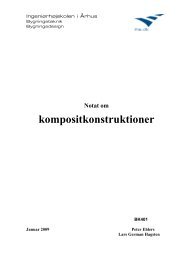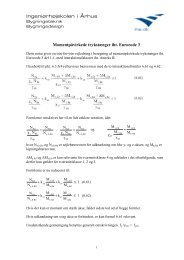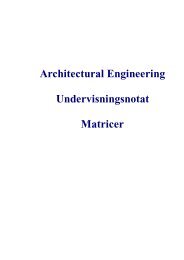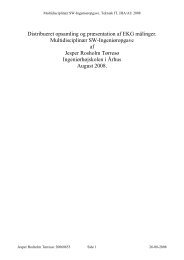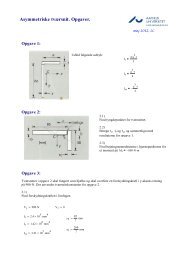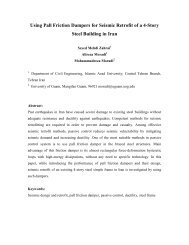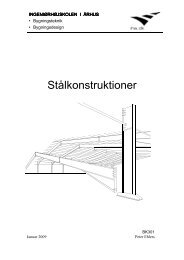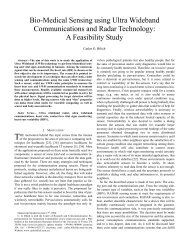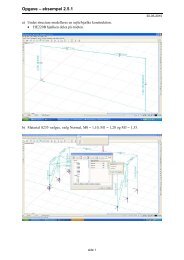vibration fatigue analysis of a cantilever beam using different fatigue ...
vibration fatigue analysis of a cantilever beam using different fatigue ...
vibration fatigue analysis of a cantilever beam using different fatigue ...
You also want an ePaper? Increase the reach of your titles
YUMPU automatically turns print PDFs into web optimized ePapers that Google loves.
VIBRATION FATIGUE ANALYSIS OF A CANTILEVER BEAM USING<br />
ABSTRACT<br />
DIFFERENT FATIGUE THEORIES<br />
Yusuf ELDOĞAN †‡ , Ender CIGEROGLU †<br />
† Middle East Technical University, 06800, Ankara, Turkey<br />
‡ ASELSAN MGEO Inc., 06750, Ankara, Turkey<br />
In this study, <strong>vibration</strong> <strong>fatigue</strong> <strong>analysis</strong> <strong>of</strong> a <strong>cantilever</strong> <strong>beam</strong> is performed <strong>using</strong> an in-house numerical code. Finite<br />
element model (FEM) <strong>of</strong> the <strong>cantilever</strong> <strong>beam</strong> verified by tests is used for the <strong>analysis</strong>. Several <strong>vibration</strong> <strong>fatigue</strong><br />
theories are used to obtain <strong>fatigue</strong> life <strong>of</strong> the <strong>cantilever</strong> <strong>beam</strong> for white noise random input and the results<br />
obtained are compared with each other. Fatigue life calculations are repeated for <strong>different</strong> damping ratios and the<br />
effect <strong>of</strong> damping ratio is studied. Moreover, <strong>using</strong> strain data obtained from <strong>cantilever</strong> <strong>beam</strong> experiments, <strong>fatigue</strong><br />
life <strong>of</strong> the <strong>beam</strong> is determined by utilizing time domain (Rainflow counting method) and frequency domain<br />
methods, which are compared with each other. In addition to this, <strong>fatigue</strong> tests are performed on <strong>cantilever</strong> <strong>beam</strong><br />
specimens and <strong>fatigue</strong> life results obtained experimentally are compared with that <strong>of</strong> in-house numerical code. It<br />
is observed that the accuracy <strong>of</strong> the damping ratio is very important for accurate determination <strong>of</strong> <strong>fatigue</strong> life.<br />
Furthermore, for the case considered, it is observed that the <strong>fatigue</strong> life result obtained from Dirlik method is<br />
considerably similar to that <strong>of</strong> Rainflow counting method.<br />
Keywords: Vibration Fatigue Theories, Rainflow Counting, Dirlik Method, Probability Density Function,<br />
Frequency Domain Fatigue Theories<br />
INTRODUCTION<br />
In <strong>vibration</strong> environments, if structures are designed only considering static requirements, due to dynamic<br />
characteristic <strong>of</strong> the environment, generally failure occurs. Hence, in order to avoid this kind <strong>of</strong> failures, dynamic<br />
characteristic <strong>of</strong> the environment and the structure should be considered. If the loading is cyclic, usually such<br />
failures occur even though stresses caused by these cyclic loadings are smaller than yield or ultimate strength <strong>of</strong><br />
the material. These kinds <strong>of</strong> failures caused by cyclic loadings are called "Fatigue". However, especially in<br />
military environments, generally structures are exposed to random loading; hence, the resulting stresses are not
cyclic. In order to avoid <strong>fatigue</strong> due to random loading, <strong>fatigue</strong> life <strong>of</strong> structures should be calculated <strong>using</strong><br />
<strong>vibration</strong> <strong>fatigue</strong> approaches in time and frequency domains.<br />
In the following sections, firstly, brief information about <strong>vibration</strong> <strong>fatigue</strong> approaches used in this study is<br />
described. These <strong>fatigue</strong> life estimation approaches are employed in order to determine the <strong>fatigue</strong> life <strong>of</strong> an<br />
example <strong>cantilever</strong> <strong>beam</strong>. In addition to this, <strong>fatigue</strong> life <strong>of</strong> the <strong>cantilever</strong> <strong>beam</strong> is determined experimentally, by<br />
utilizing several <strong>cantilever</strong> <strong>beam</strong>s and an average <strong>fatigue</strong> life is determined. The results obtained from <strong>different</strong><br />
<strong>fatigue</strong> approaches are compared with each other and also with the experimental data.<br />
THEORY<br />
In frequency domain, expected <strong>fatigue</strong> damage, ED , caused by random loading is given as follows[1];<br />
n<br />
ED . (1)<br />
N<br />
where, n and N are the number <strong>of</strong> stress cycles applied at a fixed stress amplitude and the number <strong>of</strong> cycles the<br />
material can withstand at applied fixed stress amplitude, respectively.<br />
In order to calculate ED, firstly Probability Density Function (PDF), p S , <strong>of</strong> rainflow stress ranges should be<br />
determined. A typical PDF is shown in Fig. 1 [2].<br />
Fig. 1 Probability Density Function (PDF)<br />
The bin widths, dS and total number <strong>of</strong> cycles in the histogram, S t should be obtained in order to calculate PDF<br />
from a stress range histogram. The opposite work can also be performed <strong>using</strong> PDF. The area shown in Fig. 1,<br />
p S dS,<br />
gives the probability <strong>of</strong> stress ranges between<br />
widths.<br />
p(S)<br />
dS<br />
Stress (S)<br />
dS dS<br />
Si and Si where i indicates the number <strong>of</strong> bin<br />
2<br />
2<br />
Finally, multiplying the probability <strong>of</strong> stress ranges with the total number <strong>of</strong> cycles, S t , in the histogram, the<br />
number <strong>of</strong> total cycles, nS , for a given stress level, S , can be obtained as follows [2]:
n( S) p( S) dS St<br />
. (2)<br />
In order to use Eq. (1), nS is obtained from PDF. For a given stress level, S , total number <strong>of</strong> cycles, NS ,<br />
which cause failure, can be obtained by <strong>using</strong> Wohler curve formulation, which is defined as :<br />
b<br />
N C S <br />
. (3)<br />
In Eq. (3), b is Basquin exponent and C is a material constant.<br />
Finally, by substituting Eq. (2) and Eq. (3) into Eq. (1), expected <strong>fatigue</strong> damage, ED, can be found as:<br />
<br />
<br />
niS St<br />
b<br />
<br />
NS C<br />
. (4)<br />
E D S p S dS<br />
i<br />
i<br />
0<br />
In frequency domain, Power Spectral Density (PSD) obtained from random time histories is the most widely used<br />
expression for the calculation <strong>of</strong> <strong>fatigue</strong> life if <strong>vibration</strong> <strong>fatigue</strong> theory is used [3].<br />
There are many <strong>different</strong> techniques that determine the PDF as functions <strong>of</strong> four spectral moments <strong>of</strong> the PSD<br />
( m0, m1, m2, m 4).These<br />
spectral moments <strong>of</strong> the PSD given in Fig. 2 are expressed as G<br />
k f<br />
k [1]<br />
m<br />
m<br />
n<br />
n<br />
<br />
0<br />
G f df f<br />
k<br />
G k f<br />
k f<br />
, (5)<br />
k 1<br />
where f , G<br />
k f<br />
k <br />
and f are frequency, PSD and frequency increment, respectively.<br />
Fig. 2 Power Spectral Density <strong>of</strong> Stress<br />
In 1954, a very important relationship is developed by S.O Rice [4], for the number <strong>of</strong> upward mean crossings per<br />
second, EP , and peaks per second, E 0 , in terms <strong>of</strong> the spectral moments defined by Eq. (5) in a random<br />
signal. The relationships developed by Rice can be given as follows;<br />
m m<br />
E P E<br />
, 0 <br />
2<br />
Stress<br />
Hz<br />
4 2<br />
. (6)<br />
m2 m0<br />
By utilizing Eq. (6), irregularity factor can be defined as<br />
f k<br />
Gk ⋅ fk<br />
Frequency Hz
0 <br />
2<br />
2<br />
E m<br />
<br />
E P m m<br />
0 4<br />
. (7)<br />
Theoretically, this factor can only take a value in the range <strong>of</strong> 0 to 1. If the value is 1, the process is narrow band<br />
otherwise; it tends to be white noise. It should be noted that;<br />
EPT St,<br />
(8)<br />
where, T is <strong>fatigue</strong> life in seconds.<br />
By substituting Eq. (8) into Eq. (4), expected damage formulation is obtained as<br />
<br />
<br />
niS EPT b<br />
<br />
NS C , (9)<br />
E D S p S dS<br />
i<br />
i<br />
0<br />
which can be used in frequency domain applications. By setting ED equal to 1, <strong>fatigue</strong> life, T , can be obtained.<br />
However, it is worth noting that, while calculating <strong>fatigue</strong> damage by <strong>using</strong> Eq. (9), an appropriate cut-<strong>of</strong>f value<br />
should be used for the upper limit <strong>of</strong> integration.<br />
Bendat [5] first proposed a frequency domain solution, which gives conservative results for wide-band<br />
applications. Therefore, Bendat’s solution is also called as a Narrow-Band solution. As a result <strong>of</strong> this, for<br />
Narrow-Band solution, probability density function and expected damage are given as follows:<br />
S<br />
pS e<br />
4 m<br />
<br />
NB<br />
0<br />
S<br />
2<br />
8m0 , (10)<br />
2<br />
<br />
S<br />
niS EPT b S 8m0 NS C . (11)<br />
4<br />
m<br />
E D S e dS<br />
i<br />
i<br />
0<br />
0<br />
In order to solve the problem <strong>of</strong> getting conservative results from narrow-band solutions, many expressions are<br />
investigated. The first expression for expected damage developed by Wirsching [6] is<br />
c<br />
<br />
1 1 <br />
E D E D a a , (12)<br />
NB<br />
where, ED is the expected damage determined by narrow-band solutions and<br />
NB<br />
a 0.926 0.033b,<br />
c 1.587b 2.323,<br />
2<br />
1<br />
. (13)<br />
<br />
Later, Tunna [7] replaced the expression <strong>of</strong> probability density function given in narrow-band solution with the<br />
following one<br />
S<br />
pS e<br />
4 m 0<br />
S<br />
2<br />
8m0 . (14)
Expected <strong>fatigue</strong> damage, ED , given by Eq.(9) can be also described as follows<br />
<br />
E P T<br />
ED Seq<br />
(14)<br />
C<br />
where, S eq is equivalent stress.<br />
In order to find equivalent stress, Hancock [8] first proposed the following expression<br />
b Seq 2 2m 1<br />
Hancock<br />
<br />
2<br />
<br />
<br />
0 <br />
1<br />
b<br />
Chaudhuery and Dover [9] used a <strong>different</strong> expression for equivalent stress<br />
1<br />
b2 b<br />
b b b <br />
2 2 1 2 2<br />
22 2 2 2 2 <br />
S m0 erf eq CandD<br />
However, the simplest form <strong>of</strong> equivalent stress is given by Steinberg [10] as<br />
b b b<br />
1<br />
b<br />
S 0.6832 m0 0.2714 m0 0.0436 m0<br />
<br />
eq Steinberg<br />
(15)<br />
. (16)<br />
<br />
<br />
(17)<br />
The best correlation in order to find probability density function is proposed by Dirlik [11] and it is given as<br />
2<br />
Z Z<br />
Z<br />
2<br />
1 Q 22 R<br />
2<br />
e e D 2<br />
2<br />
3 Ze D D Z<br />
pS ( ) <br />
Q R<br />
2<br />
m<br />
where,<br />
0<br />
2 2<br />
2( xm ) 1D1D1 1D1D2<br />
1 ,<br />
2 2 , 3 <br />
D D D<br />
1<br />
<br />
1R 1R<br />
, (18)<br />
.<br />
Dirlik investigated this method without <strong>using</strong> narrow-band solution. This empirical closed form <strong>of</strong> PDF is<br />
obtained by <strong>using</strong> computer simulations based on Monte Carlo technique [1].<br />
RESULTS<br />
An Aluminum 6061 T6 <strong>beam</strong> shown in Fig. 3 is used for case studies, finite element model (FEM) <strong>of</strong> which is<br />
verified by tests[12].
Case Study 1<br />
In this case study, <strong>fatigue</strong> analyses and tests are performed <strong>using</strong> the white noise PSD acceleration given in Fig. 4<br />
as base input.<br />
AMPLITUDE (g 2 /HZ)<br />
0.18<br />
0.16<br />
0.14<br />
0.12<br />
0.1<br />
0.08<br />
0.06<br />
0.04<br />
0.02<br />
0<br />
411<br />
350<br />
Fig. 3 Dimensions <strong>of</strong> the Cantilever Beam<br />
PSD INPUT<br />
50 100 150 200 250 300 350 400 450 500<br />
FREQUENCY (HZ)<br />
Fig. 4 PSD Input Acceleration for Fatigue Analysis<br />
Experimental setup is shown in Fig. 5 where the <strong>beam</strong> is fixed to shaker. Since the experimental setup is<br />
configured perpendicular to gravity direction, there is no mean component <strong>of</strong> the stress can be neglected. The test<br />
is stopped when the crack is observed and the time from the beginning to the end <strong>of</strong> the test is accepted to be the<br />
<strong>fatigue</strong> life <strong>of</strong> the <strong>cantilever</strong> <strong>beam</strong>. The test is repeated for seven <strong>cantilever</strong> <strong>beam</strong>s and the average <strong>of</strong> the results is<br />
accepted as the <strong>fatigue</strong> life <strong>of</strong> the <strong>beam</strong>. The <strong>fatigue</strong> life results for the seven test items and average <strong>of</strong> them is<br />
given in Table 1.<br />
3<br />
7<br />
1.5<br />
R 1.5<br />
50
Fig. 5 Experi imental Setup p for Cantilevver<br />
Beam Fatiigue<br />
Test<br />
Ta able 1 Fatigue e Life <strong>of</strong> Testt<br />
Specimens<br />
CONDITION<br />
TE EST ITEM 1<br />
TE EST ITEM 2<br />
TE EST ITEM 3<br />
TE EST ITEM 4<br />
TE EST ITEM 5<br />
TE EST ITEM 6<br />
TE EST ITEM 7<br />
AVE ERAGE LIF FE<br />
FATIGGUE<br />
LIFE (s) )<br />
FFatigue<br />
life <strong>of</strong> o <strong>cantilever</strong> <strong>beam</strong> is calculated<br />
<strong>using</strong> <strong>different</strong> vibbration<br />
fatiguue<br />
theories ass<br />
mentioned iin<br />
Theory<br />
ssection.<br />
The obtained o fatig gue life results s together wit th experimenttally<br />
obtainedd<br />
<strong>fatigue</strong> life aare<br />
given in TTable<br />
2. It<br />
ccan<br />
be conclu uded from the e results obta ained that Dir rlik [11] methhod<br />
generallyy<br />
gives the mmost<br />
accurate results <strong>of</strong><br />
f<strong>fatigue</strong><br />
life. In n addition, co omparison <strong>of</strong> f the location ns <strong>of</strong> crack innitiation<br />
estimmated<br />
from bboth<br />
finite eleement<br />
and<br />
eexperimental<br />
setup is show wn in Fig. 6, which w are in good g agreement<br />
IIn<br />
addition, in n order to obs serve how the e damping rat tio affects thee<br />
<strong>fatigue</strong> life results <strong>of</strong> thee<br />
<strong>cantilever</strong> b<strong>beam</strong>,<br />
four<br />
d<strong>different</strong><br />
fatig gue life analy yses are perf formed <strong>using</strong> 0.5%, 1%, 1.5% and 2% % constant ddamping<br />
ratioos<br />
and the<br />
rresults<br />
includi ing that <strong>of</strong> id dentified damp ping ratio are e given Tablee<br />
3. It is observed<br />
from thee<br />
results that, , damping<br />
rratio<br />
<strong>of</strong> the st tructure affects<br />
the <strong>fatigue</strong> e life significa antly. Hence, , accurate ideentification<br />
<strong>of</strong>f<br />
the dampingg<br />
ratios is<br />
ccrucial<br />
in the estimation <strong>of</strong> f <strong>fatigue</strong> life.<br />
1320<br />
1260<br />
1250<br />
1380<br />
1200<br />
1400<br />
1200<br />
1287
Table 2 Fa atigue Life <strong>of</strong> Cantilever Be eam Predicted d by Differennt<br />
Vibration FFatigue<br />
Theorries<br />
and Experriments<br />
MET THOD<br />
NARROW-BAND<br />
WIRC CHING<br />
TUN NNA<br />
HANC COCK<br />
KAM and d DOVER<br />
STEIN NBERG<br />
DIR RLIK<br />
EXPER RIMENT<br />
Fi ig. 6 Location ns <strong>of</strong> the Crac ck Initiation for fo Both Finitee<br />
Element andd<br />
Manufacturred<br />
Models<br />
Table 3 Fati igue Life Resu ults <strong>of</strong> Cantilever<br />
Beam foor<br />
Three Diffeerent<br />
Dampinng<br />
Ratios<br />
FATI IGUE THOR RIES<br />
FREQUENCY<br />
Y<br />
DOMAIN<br />
0.5 5%<br />
DAM MPING<br />
RAT TIO<br />
FATIGUE<br />
(s)<br />
9.57E+0 01 1.59E+00<br />
1.59E+0 02 22.65E+00<br />
6.05E+0 02 1.01E+01<br />
3.76E-0 03 66.27E-05<br />
3.76E-0 03 66.27E-05<br />
3.76E-0 03 66.27E-05<br />
9.84E+0 02 1.64E+01<br />
1.29E+0 03 22.15E+01<br />
1%<br />
DAM MPING<br />
RATIO R<br />
NA ARROW-BAN ND 1.47E E+02 2.5 58E+02 44.13E+02<br />
WIRCHING<br />
W G 2.45E E+02 4.2 29E+02 66.87E+02<br />
TUNNA 1.22E E+03 4.2 26E+03 11.08E+04<br />
HANCOCK<br />
H<br />
5.04 4E-03 5.2 25E-03 55.35E-03<br />
KAM M and DOV VER 5.04 4E-03 5.2 25E-03 55.35E-03<br />
STEINBERG<br />
S G 5.04 4E-03 5.2 25E-03 55.35E-03<br />
DIRLIK 1.41E E+03 2.9 90E+03 55.00E+03<br />
% DIFFERRENCE<br />
LIFE FATIIGUE<br />
LIFE<br />
WITHH<br />
(min)<br />
EXPERIMEENTAL<br />
FATIGGUE<br />
LIFE ( (s)<br />
1.5%<br />
DDAMPING<br />
RATIO<br />
93<br />
88<br />
53<br />
100<br />
100<br />
100<br />
24<br />
-<br />
2%<br />
DAMPING<br />
RATIO<br />
6.73E+02<br />
1.12E+03<br />
2.21E+04<br />
6.60E+00<br />
5.44E-03<br />
5.44E-03<br />
8.35E+03<br />
IDENTIFIEED<br />
DAMPINGG<br />
RATIO<br />
9.57E+01<br />
1.59E+022<br />
6.05E+022<br />
3.76E-03<br />
3.76E-03<br />
3.76E-03<br />
9.84E+022
Case Study 2<br />
In this case study, firstly, rainflow counting algorithm is developed according to ASTM E 1048 85 [13] and it is<br />
used in time domain <strong>fatigue</strong> life calculations. In order to compare the <strong>fatigue</strong> life results obtained in time and<br />
frequency domains, stress history <strong>of</strong> the location where strain gage is placed on the <strong>cantilever</strong> <strong>beam</strong> is obtained<br />
both in time and frequency domains. Strain gage cannot be located on the most critical location exactly due to<br />
geometric properties <strong>of</strong> the notch and strain gage; hence, the measured data is used only for comparison <strong>of</strong> time<br />
domain and frequency domain methods. In this case study, strain gage data is obtained by <strong>using</strong> a 0.001 g 2 /Hz<br />
White Noise PSD input. Using developed rainflow algorithm, rainflow counting <strong>of</strong> the stress-time history given in<br />
Fig. 7 is performed and <strong>fatigue</strong> life is obtained. Then, <strong>using</strong> the stress PSD data presented in Fig. 8, <strong>fatigue</strong> life is<br />
calculated utilizing <strong>different</strong> <strong>fatigue</strong> theories and all the results are presented in Table 4<br />
NORMAL STRESS sigmax (MPa)<br />
80<br />
60<br />
40<br />
20<br />
0<br />
-20<br />
-40<br />
-60<br />
STRESS RESPONSE<br />
-80<br />
0 10 20 30<br />
TIME (s)<br />
40 50 60 70<br />
Fig. 7 Stress Data for 0.001 g 2 /Hz White Noise PSD<br />
Input at the Critical Location<br />
10 20 30 40 50 60 70 80 90 100<br />
FREQUENCY (HZ)<br />
Fig. 8 Stress PSD Data for 0.001 g 2 /Hz White Noise PSD<br />
Input at the Critical Location<br />
Table 4 Fatigue Life Results Calculated in Time and Frequency Domains<br />
FATIGUE THEORIES FATIGUE LIFE (s) FATIGUE LIFE (h)<br />
FREQUENCY DOMAIN - -<br />
Narrow-band 4.14E+09 1.15E+06<br />
Wirching 6.89E+09 1.91E+06<br />
Tunna 9.95E+09 2.76E+06<br />
Hancock 1.72E+07 4.78E+03<br />
Kam and Dover 1.93E+07 5.37E+03<br />
Steinberg 7.08E+06 1.97E+03<br />
Dirlik 1.40E+10 3.89E+06<br />
TIME DOMAIN - -<br />
Rainflow Counting 1.43E+10 3.97E+06<br />
AMPLITUDE (MPa 2 /HZ)<br />
10 2<br />
10 1<br />
10 0<br />
10 -1<br />
10 -2<br />
10 -3<br />
STRESS RESPONSE PSD
Using the same stress history, it is expected to have similar <strong>fatigue</strong> life results calculated by time and frequency<br />
domain methods. However, when the results in Table 4 are studied, it is observed that Dirlik method gives the<br />
closest result to that <strong>of</strong> Rainflow counting.<br />
CONCLUSION<br />
In this study, firstly descriptions <strong>of</strong> <strong>vibration</strong> <strong>fatigue</strong> approaches are given which are used for <strong>fatigue</strong> life<br />
predictions. An Aluminum 6061 T6 <strong>cantilever</strong> <strong>beam</strong> is used for all case studies. In addition, several <strong>fatigue</strong> tests<br />
are performed in order to compare the results obtained by <strong>fatigue</strong> life prediction approaches with experimentally<br />
obtained <strong>fatigue</strong> lives. It is observed that <strong>fatigue</strong> life obtained <strong>using</strong> Dirlik method is the closest and smaller than<br />
the experimental <strong>fatigue</strong> lives. In addition, by performing <strong>fatigue</strong> life calculations <strong>using</strong> <strong>different</strong> damping ratios,<br />
effect <strong>of</strong> the accurate identification <strong>of</strong> the damping ratio is brought out to be crucial. Finally, <strong>using</strong> <strong>different</strong><br />
loading and strain gage data, <strong>fatigue</strong> life results are obtained in both frequency and timed domains. For time<br />
domain calculations, rainflow counting algorithm is developed and it is observed that the results obtained <strong>using</strong><br />
Dirlik method and rainflow counting.method are very similar to each other.<br />
REFERENCES<br />
[1] N. W. M. Bishop and F. Sherratt, Finite Element Based Fatigue Calculations. NAFEMS, GERMANY,<br />
2005.<br />
[2] N. Bishop, “Fatigue Analysis <strong>of</strong> a Missile Shaker Table Mounting Bracket,” Time.<br />
[3] M. Aykan, “VIBRATION FATIGUE ANALYSIS OF EQUIPMENTS USED IN,” M.Sc. Thesis, Middle<br />
East Technical University, Ankara, 2005.<br />
[4] S. O. Rice, “Mathematical Analysis <strong>of</strong> Random Noise,” Selected Papers on Noise and Stochastic<br />
Processes, Dover, New York, 1954.<br />
[5] J. S. Bendat, “Probability functions for random responses,” NASA report on contract NAS-4590, 1964.<br />
[6] P.H. Wirsching and M. C. Light, “Fatigue under wide band random loading”, Journal <strong>of</strong> Structural<br />
Division,” pp. ASCE, pp. 1593–1607, 1980.<br />
[7] J. M. Tunna, “Fatigue Life Prediction for Gaussian Random Loads at the Design Stage,” Fatigue Fact<br />
Engineering Mat. Struct, vol. vol. 9, no. 3, pp. 169–184, 1986.<br />
[8] J. C. P. Kam and W. D. Dover, “Fast Fatigue Assessment Procedure for Offshore Structures under<br />
Random Stress History,” Proceedings <strong>of</strong> the Institution <strong>of</strong> Civil Engineers, vol. 85, pp. 689–700, 1988.
[9] G. K. Chaudhury and W. D. Dover, “Fatigue <strong>analysis</strong> <strong>of</strong> <strong>of</strong>fshore platforms subject to sea w a v e<br />
loadings,” International Journal <strong>of</strong> Fatigue, vol. 1, no. 1, pp. 13–19, 1985.<br />
[10] D. S. Steinberg, Vibration Analysis for Electronic Equipment, 3rd ed. John Wiley & Sons, 2000.<br />
[11] T. Dirlik, “Application <strong>of</strong> computers in Fatigue Analysis,” University <strong>of</strong> Warwick, 1985.<br />
[12] Y. Eldogan and E. Cigeroglu, “Vibration Fatigue Analysis <strong>of</strong> a Cantilever Beam Exposed to Random<br />
Loading.” The 15th International Conference on Machine Design and Production, Pamukkale, Denizli,<br />
Turkey, 2012.<br />
[13] “ASTM Designation E 1049-85: Standard Practices for Cycle Counting in Fatigue Analysis 1,” Read, vol.<br />
85, no. Reapproved, pp. 1–10, 1997.



